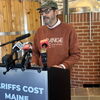
Processing Your Payment
Please do not leave this page until complete. This can take a few moments.
Home food advantage: Connecting farmers and buyers, Forager finds its way
 Photo / Tim Greenway
David Stone, executive chairman and founder of Forager
Photo / Tim Greenway
David Stone, executive chairman and founder of Forager
David Stone launched Forager to promote the local food movement by cutting out the middlemen between farmers and grocers. Online since 2017, the app connects food producers — everyone from vegetable growers and poultry breeders to fishermen — directly to stores, reducing distribution headaches and putting more local ingredients on the shelves.
The digital supply system didn’t break through overnight, though. “Early on, it was really hard to get people to change,” says Stone. “Change is hard. It’s been very hard.”
Then came COVID-19.
Forager was making inroads in the Northeast before the pandemic struck. In March, progress came to a halt.
“Stores were too busy trying to figure out how to keep their employees safe, how to stock toilet paper, how to set up e-commerce so people could buy online,” Stone says.
But over time, the pandemic – with its restrictions on travel, indoor activities and social gatherings – has given a boost to the local food movement. People have become more health conscious, those in the industry say, and want to know where their food is coming from.
In the last three months, Forager has seen a dramatic increase in demand.
“We’re getting a lot of interest all across the nation because of the need to differentiate, and because consumers are speaking in volumes about the desire to eat healthy local food for their immune systems,” Stone says.
Forager’s digital platform is free for producers, who input their product information, including prices and availability. Buyers — grocers and co-ops — pay a fee to join, and order from local producers through the platform, which also keeps track of things like inventory and sales trends.
After a couple years of development, Forager launched in March 2017. Five months later it was named by the Forbes Technology Council as one of eight startups across the country that will transform their industry.
The app has 40 buyers in Maine, New Hampshire, Massachusetts, Connecticut, New York, Iowa and New Mexico, and more than 400 suppliers in those states as well as Vermont and Kansas.
Forager accounts for $250,000 to $400,000 a month in local food volume and Stone estimates that it’s used for 5% of Maine’s local food transactions.
“COVID hurt us in the beginning, but now it’s opening up new markets,” he says.
‘Local community stepped up’
At the Portland Food Co-op, General Manager John Crane said solid relationships with local producers paid off at the store when pandemic reality set in. Other stores that rely on the traditional supply chain had empty shelves, but the co-op thrived.
“When it hit, and the stores were seeing a run on everything, we didn’t have the same scarcity,” he says. “The local food community really stepped up.”
Relationships with local producers came in handy, especially for meat and poultry, as large processing plants across the country shut down because of COVID-19 outbreaks. But local contacts also made it easier to get hold of items like kale, or ingredients for sourdough bread, Crane says.
When the co-op was running short on something, he’d put the call out to producers. A lot of that was made possible through Forager, where buyers can search specific products, but he also picked up the phone and called around, the old-fashioned way.
Nine months into the pandemic, the co-op, which has been in business since 2014, has developed a broader network of suppliers as well as a throng of new customers.
Demand for healthy food
An October survey commissioned by Forager found that more than 90% of consumers think it’s important to feed their family fresh healthy food, that they believe local food is healthy, and they’re willing to find a store that sells it.

A New York Times story from May underlines that finding, saying many small farms have had sharp increases in business this year by selling directly to consumers, generating revenues to take some of the sting out of losing restaurant customers.
Stone says that as grocery stores adjusted to the pandemic, consumers found they could buy “center of the store” items like Pepsi and macaroni-and-cheese mixes online.
“One of the ways to get people back into stores is to have fresh, local products,” Stone says. “People tend to want to touch and see their produce, their fish. They want to have more of a relationship with their food and see it.
“In the last few months, a lot of grocers are realizing they have to up their local game to be competitive against online sellers,” he says.
‘Exactly what we needed’
Crane says the co-op, at 290 Congress St., near the foot of Munjoy Hill, has attracted a lot of new customers this year.
“There are people shopping here who I just don’t recognize,” he says.
He chalks it up to the store’s early and strict COVID-19 measures, but also the “health awareness” message that he hears from customers. “People are cooking at home, they’re seeking different foods, but fresh, good and healthy food,” he says.
The co-op was Forager’s first customer. Crane says it made connecting with local producers more efficient and productive from the start, and that became vital after the pandemic started.

Despite the fact it was a startup, he was never skeptical. “This is exactly the type of thing we needed,” he says.
Aside from efficiency — no more paper records, plus smoother tracking of inventory, prices and who has what in stock — it also makes finding producers easier than the old method of cold calls and word of mouth.
Now, “If we want to buy romaine lettuce, for example, we can see everyone on the platform who sells romaine lettuce,” he says.
Paring down the process
Stone has been involved in at least 20 startups by his estimation, but Forager is his first impact venture.
On a trip around the world several years ago, he saw how food distribution worked in other places, and it was dramatically different from how it works here.
“It just started to dawn on me: Why is America such an industrialized system and why isn’t there more local food?” he says. Stone sensed an opportunity, as well as a challenge.
The $12 trillion global agriculture industry is the largest contributor of carbon in the world. Part of that is generated by huge industrial farms, with more coming from the multitude of links in the supply chain, Stone says.
“The journey from California for lettuce, it’ll be handled by four to five systems from the truck to the processing plant to the palleting, to a regional distribution center.” By the time it gets to a grocery store distribution center, “It’s traveled 10 days, then it’s redistributed,” he says.
The aim with Forager was to cut the journey down to the basics — from the farm right to the store.
Part of his mission with his previous app, CashStar, was to put together a tech industry payment system in Maine. He realized he could build on that concept.
“We should be leaders in agriculture technology in the state, given our huge agriculture area and all the rest of the stuff we’re doing,” he says. “For instance, we have more cheesemakers in Maine than in Vermont. There’s a huge opportunity.”
The concept is simple: help farmers find stores and stores find farmers, while providing fresh, local food to the consumers who say they want it.
Getting there
Forager’s longtime buyers are local co-ops, the six-store Rosemont Market and Bakery chain, and others. Recently the company has landed bigger fish. In October, Roche Bros., a Boston-area supermarket chain, signed on. Roche’s 21 stores will connect directly with local producers for food and other products, bypassing central distribution.
Roche “really prides itself on being a local company, and we really love working with local products,” Arthur Ackles, vice president of merchandising and buying, told New England Cable News recently. “Forager gives us a lot of access to local products that we don’t have now.”
Forager isn’t limiting itself to grocery chains. Partnerships include Central Maine Medical Center, MaineHealth, the University of Maine’s flagship campus in Orono and the Maine Department of Corrections.
Stone says that there aren’t limits to how the app can be used as the focus shifts, more than ever, to healthy food and sustainability.
“Our goal is to make local food available anywhere,” he says. “To make it so accessible that anybody anywhere, from any device, any time, can buy from the local community, any product they want.
“We’re getting there bit by bit,” he says.














0 Comments